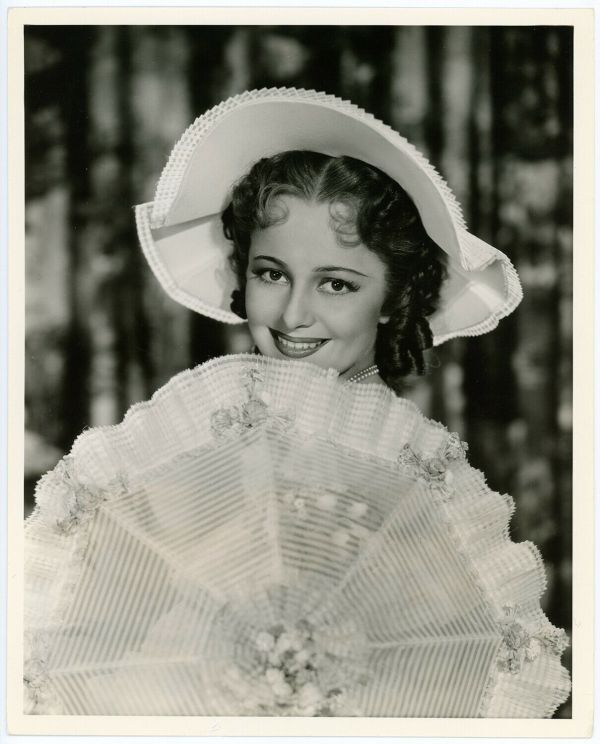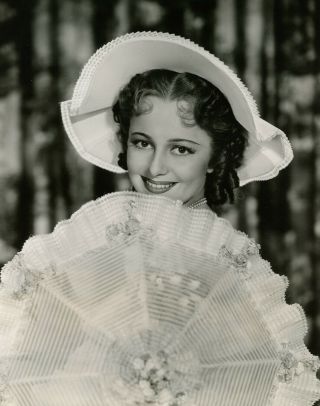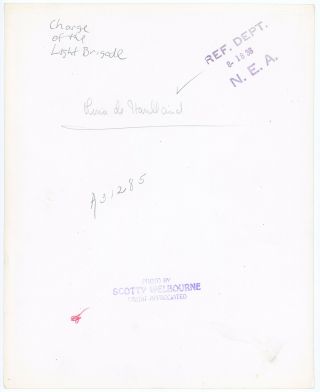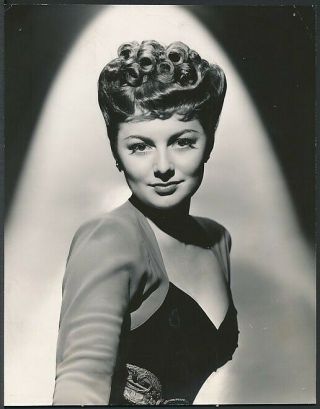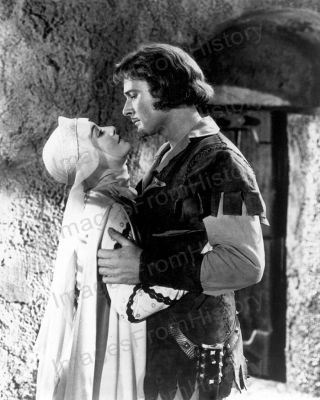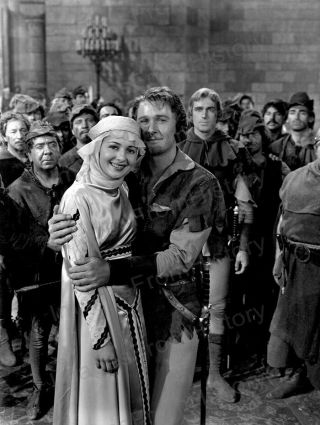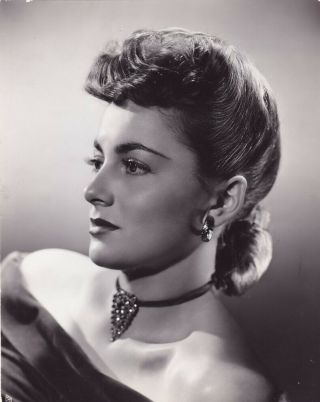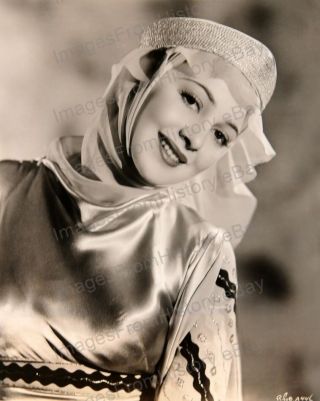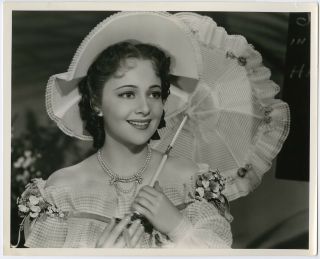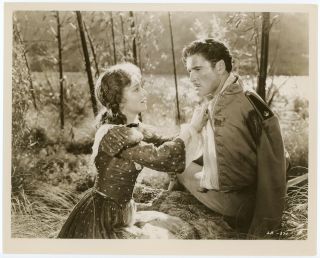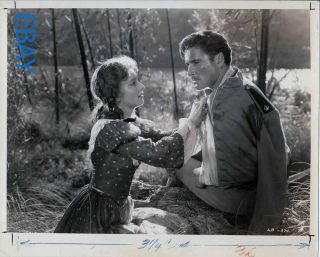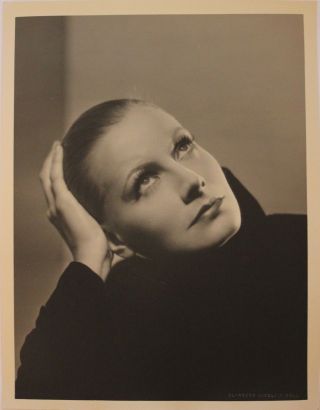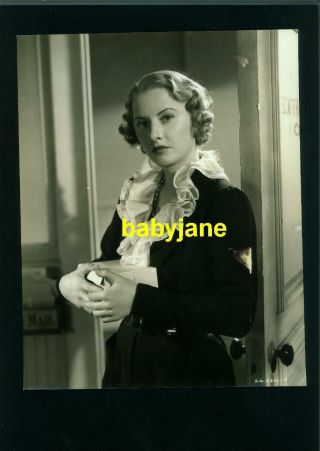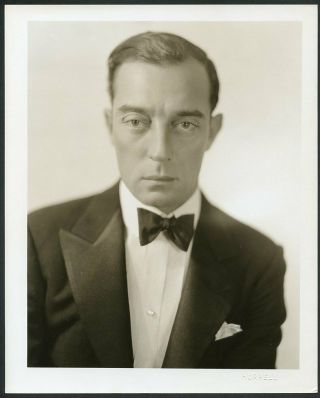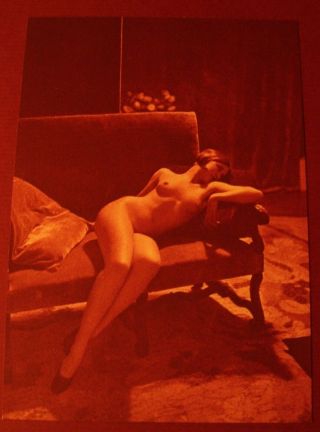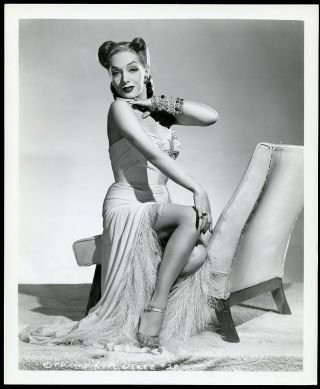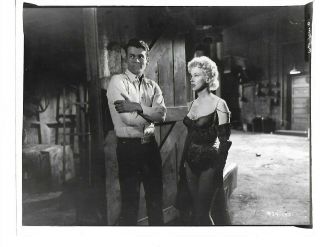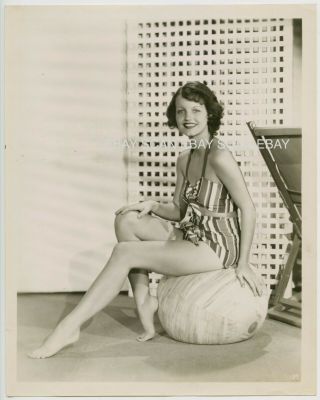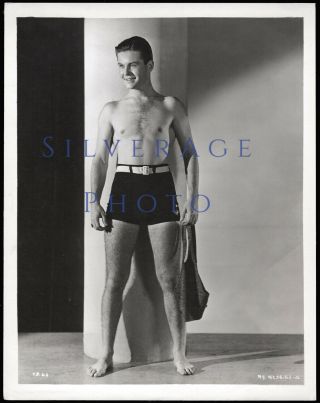Orig. 1936 Olivia De Havilland Charge Of The Light Brigade Production Photograph
Item History & Price
Best known as Melanie in "Gone with the Wind", Academy Award winning actress Olivia De Havilland appeared in 49 feature film...s and was one of the leading actors of her time. With a career spanning from 1935 to 1988, she was the oldest living and earliest surviving Academy Award winner until her death in July 2020.
Photograph measures 8" x 10" on a glossy single weight paper stock with the photographer's ink stamp and various notations on verso.
Guaranteed to be 100% vintage and original from Grapefruit Moon Gallery.
More about Olivia De Havilland:
One of the premiere leading ladies of Hollywood’s Golden Age, actress Olivia de Havilland first became known for her roles as demure ingénues opposite cinema’s most popular male stars. The older sister and professional contemporary of actress Joan Fontaine, de Havilland began her career as a contract star for Warner Bros. Pictures in 1935. Her breakout film, the swashbuckling adventure "Captain Blood" (1936) opposite Errol Flynn, was the first entry in one of filmdom’s greatest romantic onscreen pairings. She appeared with Flynn in seven more features, including "The Adventures of Robin Hood" (1938) and made history the following year with her role as the noble Melanie Hamilton Wilkes, best friend of flawed heroine Scarlett O’Hara (Vivien Leigh) in the timeless classic "Gone with the Wind" (1939). Behind the scenes, a rumored sibling rivalry between her and Fontaine was the subject of Hollywood gossip for decades. The actress won her first Academy Award for her starring role in the melodrama "To Each His Own" (1946). Embracing flawed, unglamorous characters, de Havilland garnered acclaim for her work in "The Snake Pit" (1948) and picked up a second Oscar with "The Heiress" (1949). By the 1950s, de Havilland’s film output decreased substantially, with her appearance opposite fellow icon Bette Davis in "Hush... Hush, Sweet Charlotte" (1964) being one of her more notable late-career efforts. A true luminary of the silver screen, de Havilland would always be remembered for the elegance and grace she possessed both on and off camera.
Olivia Mary de Havilland was born in Tokyo, Japan on July 1, 1916. She was the eldest daughter of Walter de Havilland, a lawyer, and the former Lilian Augusta Ruse, an actress who went by the stage name, Lilian Fontaine. Her younger sister was actress Joan Fontaine, from whom de Havilland was estranged for more than eight decades, due some said, to professional rivalry. But it surely went deeper than that, since both became accomplished actresses and even Oscar winners. The family moved from Tokyo when the future Academy Award winner was two years old, and settled in Saratoga, CA. De Havilland attended high school at Los Gatos High School, where an acting award was named after her, and also went to Notre Dame Convent Catholic Girls' School in Belmont, CA. De Havilland's career began with a co-starring role in "Alibi Ike" (1935). She appeared as Hermia in the stage production of "A Midsummer Night's Dream, " a character she later reprised in the film version that was produced by Warner Bros. in 1935. After being signed to the studio – one famous for its male-driven output of gangster films and the occasional musical – a string of "damsel in distress" roles followed. It was a character that became her trademark onscreen persona, due in part to the limitations for actresses at Warner Bros., but also one she ultimately grew frustrated with.
The young ingénue starred opposite their newest star, swashbuckler Errol Flynn in popular films like "Captain Blood" (1935), "The Charge of the Light Brigade" (1936), and as Maid Marian in the timeless classic, "The Adventures of Robin Hood" (1938). Such was their personal chemistry, the pair became of Tinseltown's most attractive and dynamic onscreen couples, appearing in eight films together. But despite rumors of any on-set romance, a la Tracy and Hepburn, de Havilland claimed she never fell for Flynn's infamous advances. The actor – who bedded virtually every woman he set his eyes on – reportedly grew fond of the actress during the filming of "Captain Blood, " and by the time they were filming "The Charge of the Light Brigade, " he was hooked – most likely because she was the one woman to turn him down. The dashing actor was also unhappily married to actress Lili Damita at the time. In truth, the older Flynn intimidated De Havilland, who was barely in her 20s. Plus, she was rumored to have been wary of his unusual courting tactics of playing jokes on her. He was reported to have placed a dead snake in her underwear as a prank, which she, not surprisingly, did not find too amusing. But the actress did reveal that in spite of it all, she was still quite taken with Flynn. In an interview, she said, "He was a charming and magnetic man. I had a crush on him, and later I found he did for me. In fact, he proposed, but he was not divorced from Lili Damita so it was just as well that I said no." De Havilland was also romantically linked to John Huston, James Stewart and Howard Hughes in the early 1940s. She married Marcus Goodrich, a novelist, in 1946; the pair divorced in 1953. They had a son, Benjamin, who died in 1991.
De Havilland's landing the part of Melanie in the epic film "Gone with the Wind" was no easy feat for the young actress who yet to make the A-list, despite her successes with Flynn. She was still under contract with Warner in 1938 when the film's original director, George Cukor, called her to audition for the role of Melanie. The 22-year-old accepted the offer, knowing fully that she was doing something illegal. Driving herself to Cukor's office, she read for him and got the part. Almost. Warner Bros. refused to loan her out to MGM, even after she begged Jack Warner to let her do the movie. She was so desperate, she turned to Warner's wife for help, explaining how much the role meant to her. After his wife intervened, Warner let de Havilland be in the cast of what is still one of the most celebrated movies of all time. Her touching performance earned her an Academy Award nomination for Best Actress in a Supporting Role. Only she and co-star Clark Gable were shut out of wins, as Vivien Leigh as Scarlett O'Hara and Hattie McDaniels as the O'Hara servant, Mammy, both earned acting Oscars, as did the picture and its producer, David O. Selzick and the film's second director, Victor Fleming (Cukor had been replaced after Gable threw his weight around, uncomfortable with the homosexual Cukor's focus on the female characters; insisting the man's man Fleming take over the reigns).
The actress may have portrayed the demure, damsel in distress role to perfection, but in reality, de Havilland became wary of always playing the "love interest." She even mounted a famous for its time lawsuit against Warner Bros. that ultimately gave actors more creative freedom than ever before. In 1941, de Havilland sued the company over the terms of her contract. Her contract was already expired, but the studio told her that six months had been added to it for times that she had been on suspension; the studios were allowed then to suspend actors for rejecting a role and the period of suspension to be added to the contract period. Most actors accepted the situation, but de Havilland fought the system by suing the studio. The Screen Actors Guild backed her up, and she eventually won. The decision was one of the most important legal rulings in Hollywood. It was the first time actors were extended more freedom over their careers. The ruling was known as, and still is, referred to as the "de Havilland law." Warner Bros. vowed to never hire the actress again.
She need not have worried about any bad blood shed at Warner Bros. In the mid-1940s, de Havilland gained critical acceptance for playing more serious roles she has always wished to play. She won the Best Actress Academy Awards for "To Each His Own" (1946), where her character became pregnant out of wedlock, and also for "The Heiress" (1949). She received much praise for her Oscar-nominated performance in "The Snake Pit" (1948), one of the first movies to bring to light the controversial issue of mental illness. In the movie, de Havilland's character was committed to an insane asylum; the role was very unglamorous and a stark contrast to her previous roles.
Time heals all wounds, some say, but it apparently did not apply to the feud between the De Havilland sisters. De Havilland's relationship (or lack thereof) with her sister, Joan Fontaine, was one for the books. The sisters' decades-long rivalry – they stopped speaking to each other in 1976 – was fraught with hostility and jealousy that many say must have stemmed from childhood, when de Havilland ripped her sister's hand-me-downs, forcing Joan to sew them back together. Their mother must have added fuel to the fire, as she reportedly favored her elder daughter over Fontaine. During their acting careers, the sisters chased after the same roles, and were pitted against each other for several acting awards. In 1942, both sisters were up for the Best Actress award; Fontaine took home the Oscar for her role in Alfred Hitchcock's "Suspicion" (1941) over de Havilland's nomination for "Hold Back the Dawn" (1941). During the ceremony, after Fontaine's name was announced as the winner, she reportedly rejected her sister's outstretched hand, ready to congratulate her. De Havilland was humiliated by the gesture.
De Havilland continued to make films after the 1950s, but her roles were far and few between as Hollywood turned its eyes on toward younger, more permissive actresses. She reportedly turned down the role of Blanche Dubois in "A Streetcar Named Desire" (1951) because of its suggestive themes and racy dialogue. The role went to her "Gone with the Wind" co-star, Vivien Leigh, who won an Oscar. De Havilland continued to make movies until the 1970s and made several television appearances, most notably as the Dowager Empress Maria in the 1986 miniseries "Anastasia: The Mystery of Anna" (NBC), which earned her a Golden Globe award and an Emmy nomination. Having finally had her fill of Hollywood, the actress moved to Paris for the remainder of her life. She was a presenter at the 75th Annual Academy Awards in 2003 and was reportedly working on an autobiography, still the graceful, classy lady even into her ninth decade.
Biography From: TCM | Turner Classic Movies
More about Scotty Welbourne:
Scotty Welbourne was born on May 14, 1907 in North Carolina and by the end of his career he not only photographed great film stars but also became a wonderfully known cinematographer and director.
The 'mptv.net' says of Welbourne:
Scotty Welbourne replaced Elmer Fryer as department head at Warner Bros. in 1941, photographing many of the studio's newer stars, including Lana Turner, Ann Sheridan, Ida Lupino, Humphrey Bogart, and Alexis Smith, as well as Marlene Dietrich and Merle Oberon. (During the shooting of "Fools for Scandal" (1938), he took 686 pictures of Carole Lombard in one day.)
Welbourne worked at Warners into the 1940s, taking photos of studio stars such as Jane Wyman and Bette Davis.
However, movie buffs may best know Welbourne for his work in the 1950s horror genre -- he handled photography of the underwater sequences for director Jack Arnold's 1955 3-D gem "Revenge Of The Creature." Recalled Ricou Browning, who was in the gill man's suit when filming took place underwater, "The cameraman, Scotty Welbourne, also did some directing under the water. He built the housings for the two 3-D cameras, which were placed beside each other, and they flooded twice, and had to be overhauled overnight to have them ready to go the next day.”
Welbourne believed that the proper use of light and shadow was the answer to most of the photographer's problems and that "the photograph or the photographer must never overshadow the subject in importance [but] must always be of secondary importance to the star." Welbourne left Warner Bros. in 1945 to set up, with Madison Lacy and former MGM publicity photographer Bud Graybill, the stills department at Enterprise Productions, a short-lived production company that made three or four films, among them "Arch of Triumph"(1948).
He was often an uncredited still photographer for films such as "Public Enemy, " "The Sound and the Fury, " and "The Creature From the Black Lagoon."
He passed away on May 25, 1979 shortly after his 72nd birthday in Los Angeles, California. His works are on such prestigious sites as Conde Nast and Artnet.
Biography From: Vintage Movie Star Photos, The One and Only Scotty Welbourne



